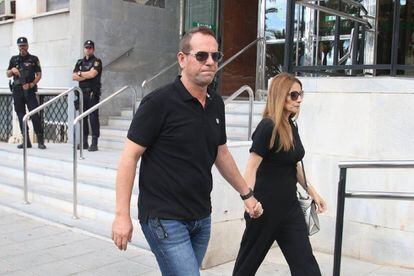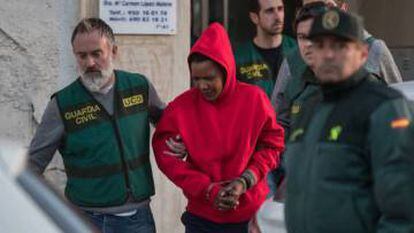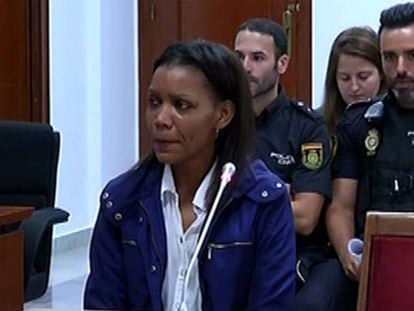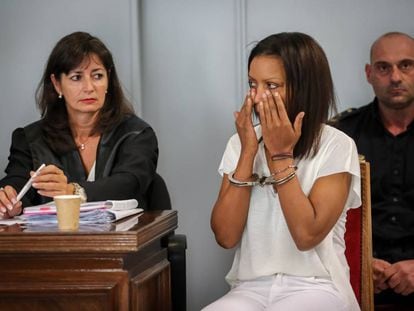Killer of Spanish eight-year-old: “Calm down Ana, you’re not going to jail”
Witnesses provide new details about defendant Ana Julia Quezada, who is facing the maximum possible prison term for the death of Gabriel Cruz in February 2018


“Calm down Ana, you’re not going to jail.”
This is how Ana Julia Quezada consoled herself on the day that she dug up the body of eight-year-old Gabriel Cruz at the rural property in southern Spain where she had killed him a few days earlier.
The words were recorded by a hidden device that the Civil Guard had planted inside her car as part of surveillance of Quezada, who was the main suspect in the crime.
Medication found in her purse would have been insufficient to commit suicide, as Quezada claims she meant to do
On Wednesday, the jury that will decide the fate of the self-confessed killer heard testimony from a Civil Guard lieutenant who was in charge of the investigation following Gabriel’s disappearance on February 27, 2018. For 11 days, there was an extensive search for the child in which Quezada actively participated, making public shows of support for Gabriel’s father, with whom she was in a relationship.
The Civil Guard officer, one of seven witnesses to take the stand at the Almería provincial court on Wednesday, said that when they arrested Quezada they found medication inside her purse: “Muscle relaxants, diazepam. Two blisters, no more than 12 pills.” This would be an insufficient amount to take her own life, as Quezada told the court she meant to do after killing Gabriel. Inside the house she shared with Gabriel’s father, Ángel Cruz, officers found a small amount of cocaine but nothing to support her claim that she was going to commit suicide by overdosing on medication.
This witness also told the court that Quezada’s frequent visits to the property where she’d buried the child – a rural home in Rodalquilar that was being renovated – was to check that no animal had dug up the body, especially since there was an unusual spell of rain during those days. “That’s why her visits were so short: she checked that everything was all right, and left again,” said the Civil Guard lieutenant.

Another witness, Civil Guard Captain José María Zalvide, said they became immediately suspicious of Quezada after she twice claimed to have lost her cellphone, and later after she planted a t-shirt that had belonged to Gabriel at a spot near the house of a former partner of hers, Sergio Melguizo, in an apparent attempt to falsely incriminate him.
A third Civil Guard witness who interrogated Quezada on March 3, the day that the shirt was found, was asked if the accused had ever shown signs of remorse.
“Not on that day nor on any other day,” he replied.
Earlier probe in Burgos
The jury heard Quezada described as “cold and calculating” by a Civil Guard captain from Burgos, the city where the accused first lived after moving to Spain from Dominican Republic. Quezada was investigated there when her four-year-old daughter died after falling out of a window in 1996. The case was ultimately dismissed as an accident.

Gabriel’s uncle Francisco Cruz also took the stand on Wednesday, and said that on a visit to the Rodalquilar estate following the child’s disappearance, he was puzzled to see a shovel, an ax and a rake placed in a meticulous row, “like when you take a test and place your pens neatly on the desk.” He knew that his brother Ángel did not keep tools there, because they had all been taken to another family property. If Quezada brought the tools with her to the property, it would support the accusation that the murder was premeditated.
Quezada has confessed to killing Gabriel but maintains that it was not planned. While she originally told the police that she was trying to get rid of the body on the day she was arrested, she has since changed her version of events and now claims that she meant to leave the body in the car, write letters to the family asking for forgiveness, and take her own life with pills.
Her defense is seeking a conviction for reckless homicide, which entails a maximum prison term of 15 years. The accusation says it is murder and wants the maximum penalty: permanent reviewable prison – the equivalent of life with a possibility of parole after a fixed term.
English version by Susana Urra.












































